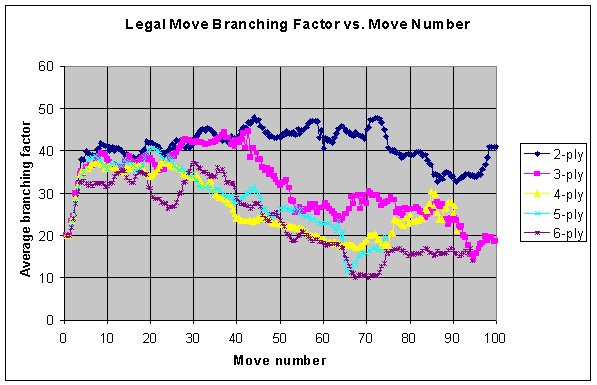
Figure 1: Branching factor vs. move number, average
of four games. Branching factor is further smoothed
by averaging over four moves within each game.

As can be seen from the data of Figure 1, the average branching factor of the chess game tree is about 30. These 30 moves are the set of possible (legal) moves from which the chessplayer selects. If we look at just the first 50 moves of the games of Figure 1, the average branching factor is about 34. In practice, however, chessplayers (human or otherwise) will choose from a small "strong" subset of the possible moves. In some cases, that strong subset will be as small as one (a forced move) and typically contains only a few moves. Chess analysts categorize the relative strength (or weakness) of a move as follows:
Blunder: leads directly to loss of the game.
Mistake: leads to serious weakness or eventual loss of the game.
Error: doesn't necessarily lead to the loss of the game, but another move is demonstrably better.
Inaccuracy: slightly weaker; another move can be shown to be better.
Imprecision: doesn't lead to weakness but another move can be shown to be more efficient.
A weak move in an annotated game is labeled with one or more question marks. A single best but non-obvious move in an annotated game is labled with an exclamation mark. Figure 2, below, shows average branching factor as a function of search depth. There seems to be a definite decreasing trend downward with search depth. This is probably due to "smarter" play (which we assume is the case when the computer looks further ahead) tending to suppress the opponent's options more than being able to increase one's own.
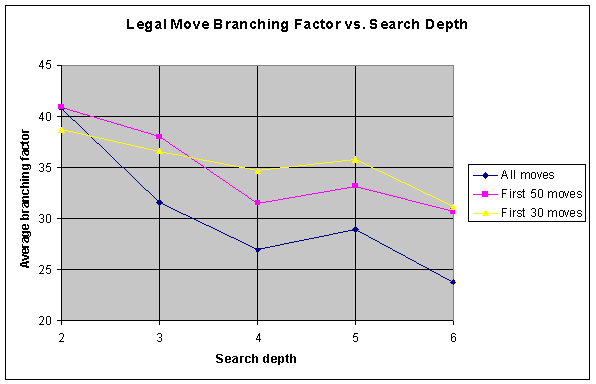
While the player is faced with an average of 30 or so legal moves on any given turn of play, he actually selects from a much smaller set of strong moves. If he fails to do so, he is faced with a weakened position. Small weaknesses are cumulative and rapidly result in defeat. Thus, expert players are walking a fine line in the game tree. Experience in tournament play, inspection of chess book openings, and over-the-board analysis leads us to the following conjecture:
Conjecture: The average branching factor of the strong chess game tree is less than two.
Chess games between competent players are generally won or lost in the middle game, so we are primarily interested in the first 30 moves of the game tree. If the conjecture is true, then storing the strong chess game tree to a depth of 30 moves (60 tempi) is feasible on a commonly available server. If the average strong move branching factor is 1.5, the number of positions to be stored is:
1.560 = 37 x 109
If each move requires a few (a hundred or so) bytes of storage, then that number of moves will fit within virtual memory in a good commercially available server. Inspection of references for "book" openings [1][2] shows the branching factor for recognized playable openings to be significantly below two. For example, in the venerable King's Gambit (1 e4 e5 2 f4 exf4 3 Nf3 g5) in Modern Chess Openings [1], the average branching factor for moves four through 10 (14 tempi) is 1.312. In the same book, the Queen's Gambit Declined, Orthodox Defense (1 d4 d5 2 c4 e6 3 Nc3 Nf6 4 Bg5 Be7 5 e3 0-0 6 Nf3 Nbd7 7 Rc1 c6 8 Bd3 dxc4 9 Bxc4 Nd5 10 Bxe7 Qxe7 11 0-0 Nxc3 12 Rxc3 e5) average branching factor for moves 13 through 19 (also 14 tempi) is 1.448.
Figure 1 shows that the legal move branching factor rises quite rapidly in the first five moves, and then levels off, so if the number of possible (legal) moves at any turn is an indication of the number of strong moves at any turn, then the analytical result for the opening stage of the game should also be applicable to the middle game. Corroborating evidence of the middle game strong move branching factor conjecture is available from analysis of some selected master chess games presented in the monthly pedagogical chess column Solitaire Chess by Bruce Pandolfini, appearing in Chess Life [6]. In the five top world player games analyzed in the April through August issues, covering white's moves ranging from move 10 through move 34, the average branching factor of strong moves is 1.08.
To investigate this conjecture and its implications, we created client-server extensions to a chess applet residing on a Web server (see http://rjwagner49.com/Robotics/Software/Applet/Chess/).
If the database move is returned to the applet, that move is used if it was computed at the same or greater search depth the applet is currently using. If not, the applet computes the move locally and sends the result to the server for storage. A functional flow diagram of the applet user and client/server interfaces is shown below in Figure 3.
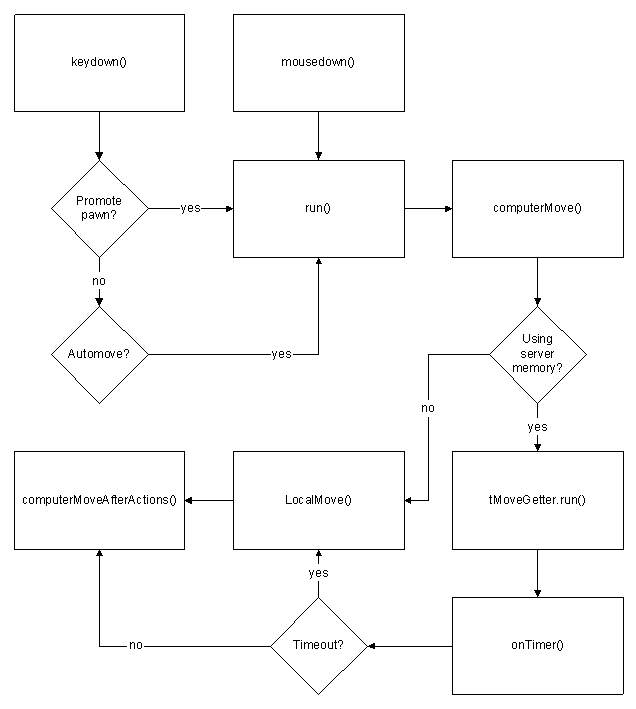
When the user performs an action such as moving a piece (the mousedown() function) or hitting a relevant keystroke (the keydown() function), an applet thread runs (the run() function) to perform the move. If server memory is not being used or if the move-getting timer times out (five seconds), the move is computed locally with the localMove() function.
For a save game request, the session ID is sent to the server along with the game data. The server saves the game file and responds with the game number with which the user can later identify the game.
To open a game, the server sends a list of the saved games for the user to select from by double clicking on the file name. When the user makes his selection, the server opens the game file and sends the data to the applet where it is displayed as a chess game configuration for continued play.
With these save and open features, a user can play a game for a while, save it, shut down the applet, and come back later and continue playing the game. Repeated saves of the game (within the same session) write to the same game file. Resetting the board requests a new session ID so that the new game will be saved to a new file name and won't write over the old file.
When a player makes a move and it's time for the applet to compute a move, it sends the game configuration to the server in a request for a remembered move. If the server doesn't find the configuration, it replies "not found." If the move is found by the server and received by the applet, and if the move was computed at the same or deeper search depth as the applet's current search depth, the move is used. If not, the applet rejects the served move and begins computing the move. When the move computation is complete, the applet displays the move, notifies the user with a "ding" sound, and sends the computed game configuration and search depth to the server for storage.
We initially attempted to have a piece-centric (rather than board-centric) model, but were not able to get away from a chessboard representation. With a piece-centric model, each piece will have knowledge of its location (or relationships to other pieces) and what its legal moves are. With a board-centric model, the board keeps the location of the pieces. Our model has aspects of both in a way that we believe is acceptable for this object oriented (OO) approach. A diagram of the chess applet object model is shown below in Figure 4:
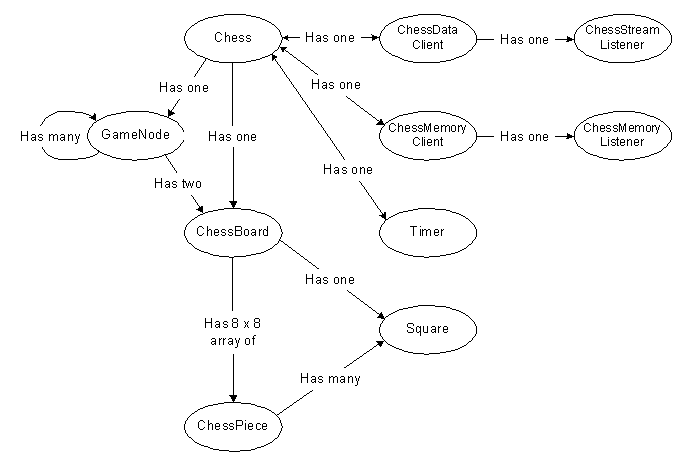
The chessboard is modeled as a 2D array of chess pieces. Empty squares have "null" for their pieces. Each piece has a "square" (rank and file) that it stands on and a list of squares it can move to in the next turn (a Vector of legal moves).
For the chess configuration space search algorithm, a tree node object is needed which has a configuration (chessboard) and a chessboard evaluation function. The game node keeps a Vector of child game nodes for recursive search (min-max with alpha-beta pruning) [7]. The game node object also has a "best" configuration to carry to the top of the tree when the search is complete. The applet itself also keeps a current board configuration. The applet also knows how to draw the chessboard and pieces and to interact with the user. To summarize, the following classes are defined:
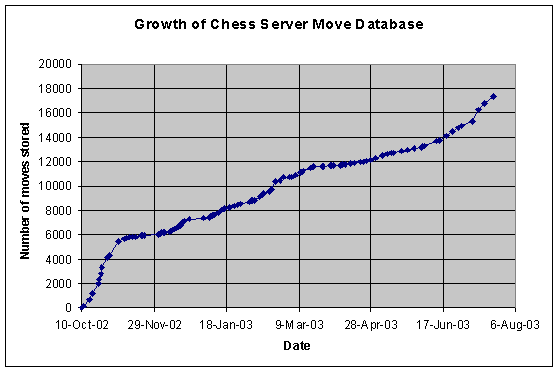
The stored move growth rate is proportional to Website chess player activity, which, after some initial stress testing, was nearly constant. The near constant database growth was expected because the Web page visitor traffic was nearly constant.
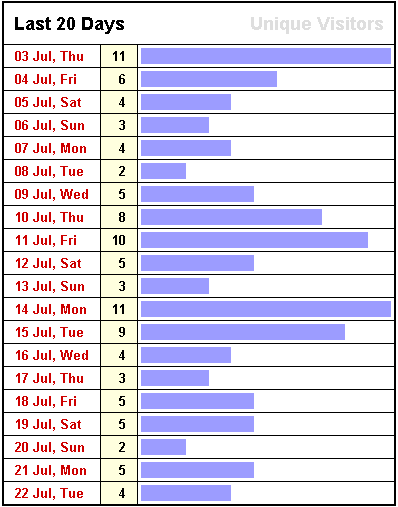
In that 20-day period, unique visitors ranged from two to 11, with an average of 5.45 per day. Unique visitors for 20 months are shown below in Figure 7:
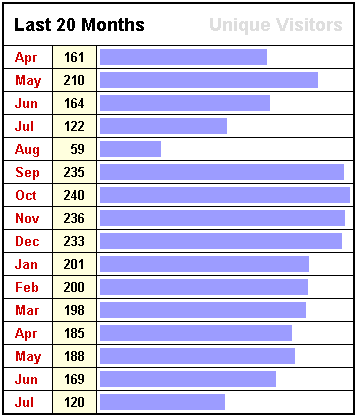
Page statistics service started in April 2002 so only 16 months are shown. The average is 183 unique visitors per month. Most visitors were referred from search engines, with Google (http://www.google.com) by far the most common with Yahoo and MSN second and third, respectively. Search keyword frequency is shown below in Figure 8:
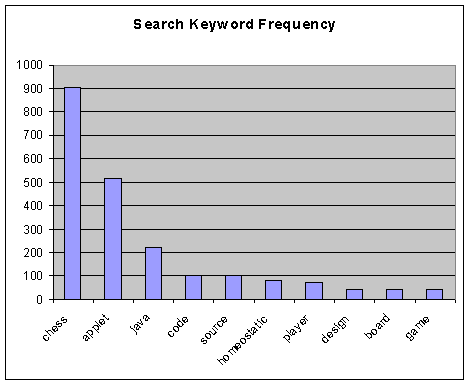
A typical search query is "chess applet source code."
0000003149, Mon Jul 21 15:11:52 GMT+01:00 2003, x86, Windows NT, 5.0, Recursion limit = 3 0000003150, Mon Jul 21 15:39:06 PDT 2003, x86, Windows NT, 5.0, Recursion limit = 4 0000003151, Tue Jul 22 02:35:32 EDT 2003, x86, Windows 98, 4.10, Recursion limit = 3 0000003152, Mon Jul 21 15:39:06 PDT 2003, x86, Windows NT, 5.0, Recursion limit = 4 0000003153, Mon Jul 21 15:39:06 PDT 2003, x86, Windows NT, 5.0, Recursion limit = 4 0000003154, Tue Jul 22 14:31:46 EDT 2003, x86, Windows XP, 5.1, Recursion limit = 3 0000003155, Tue Jul 22 19:35:26 GMT+01:00 2003, x86, Windows NT, 5.1, Recursion limit = 4 0000003156, Tue Jul 22 14:35:05 EDT 2003, x86, Windows XP, 5.1, Recursion limit = 3 0000003157, Tue Jul 22 14:36:51 EDT 2003, x86, Windows XP, 5.1, Recursion limit = 3 0000003158, Tue Jul 22 14:37:06 EDT 2003, x86, Windows XP, 5.1, Recursion limit = 3 0000003159, Tue Jul 22 12:56:04 PDT 2003, x86, Windows NT, 5.0, Recursion limit = 4 0000003160, Tue Jul 22 17:22:35 CDT 2003, x86, Windows 98, 4.10, Recursion limit = 3 0000003161, Tue Jul 22 17:25:02 CDT 2003, x86, Windows 98, 4.10, Recursion limit = 3 0000003162, Tue Jul 22 17:26:29 CDT 2003, x86, Windows 98, 4.10, Recursion limit = 3 0000003163, Tue Jul 22 15:55:44 PDT 2003, x86, Windows NT, 5.0, Recursion limit = 4 0000003164, Tue Jul 22 17:00:09 PDT 2003, x86, Windows NT, 5.0, Recursion limit = 4 0000003165, Tue Jul 22 17:09:37 PDT 2003, x86, Windows NT, 5.0, Recursion limit = 4 0000003166, Wed Jul 23 12:37:49 CST 2003, x86, Windows XP, 5.1, Recursion limit = 3 0000003167, Wed Jul 23 10:34:00 EDT 2003, x86, Windows NT, 5.0, Recursion limit = 3 0000003168, Wed Jul 23 13:12:12 EDT 2003, x86, Windows XP, 5.1, Recursion limit = 3The ten-digit number is the session ID, which is followed by the date and time, time zone, year, processor type, operating system and version, and the initial recursion limit for the applet, which is set by testing the current processor power using a base six logarithmic formula. Six is the square root of the chess tree branching factor (approximately). The square root is appropriate due to the chess tree pruning performed by the alpha-beta search algorithm [4][7]. After the initial recursion limit is set, the applet adjusts the recursion limit dynamically so that the applet thinking time average remains under 200 seconds. Threes and fours are most prevalent for the initial recursion limit. Machines that are as powerful as the one used to develop the applet (1.7 Ghz Pentium 4) will have a recursion limit of four. Lesser machines will use a lower initial recursion limit. In the future we expect to see some fives begin to appear in the statistics.
The design objectives of improving both chess applet response time and move quality for individual users were met.
Rick Wagner is a chess player and computer scientist interested in the limits of artificial intelligence.
[2] Horowitz, Israel. A., Chess Openings: Theory and Practice, Simon and Schuster, 1970.
[3] Khodarkovsky, Michael and Shankovich, Leonid, A New Era, How Garry Kasparov Changed the World of Chess, Ballantine Books, 1997.
[4] Moreland, Bruce, "Alpha-Beta Search," a Web page at http://www.seanet.com/~brucemo/topics/alphabeta.htm, July 10, 2002.
[5] Nunn, John, Burgess, Grahan, Emms, John, and Gallagher, Joe, Nunn's Chess Openings, Everyman Publishers, 1999.
[6] Pandolfini, Bruce, "Solitaire Chess," monthly column in Chess Life, April through August issues, 2003.
[7] Rich, Elaine and Knight, Kevin, Artificial Intelligence, Second Edition, McGraw Hill, Inc., 1991.
[8] Schaeffer, Jonathan and van den Herdk, H. Jaap, "Games, Computers, and Artificial Intelligence," Artificial Intelligence, 134(2002) 1-7.
 Email Richard dot J dot Wagner at gmail dot com
Email Richard dot J dot Wagner at gmail dot com
index.html
Hand crafted HTML code copyright 2001-2019, by
Dr. Rick Wagner,
all rights reserved.
This page created August 12, 2002.
Last updated March 17, 2019.